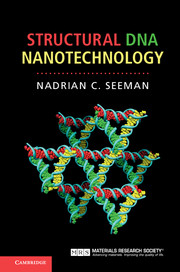Book contents
- Frontmatter
- Contents
- Preface
- 1 The origin of structural DNA nanotechnology
- 2 The design of DNA sequences for branched systems
- 3 Motif design based on reciprocal exchange
- 4 Single-stranded DNA topology and motif design
- 5 Experimental techniques
- 6 A short historical interlude: the search for robust DNA motifs
- 7 Combining DNA motifs into larger multi-component constructs
- 8 DNA nanomechanical devices
- 9 DNA origami and DNA bricks
- 10 Combining structure and motion
- 11 Self-replicating systems
- 12 Computing with DNA
- 13 Not just plain vanilla DNA nanotechnology: other pairings, other backbones
- 14 DNA nanotechnology organizing other materials
- Afterword
- Index
- References
1 - The origin of structural DNA nanotechnology
Published online by Cambridge University Press: 05 December 2015
- Frontmatter
- Contents
- Preface
- 1 The origin of structural DNA nanotechnology
- 2 The design of DNA sequences for branched systems
- 3 Motif design based on reciprocal exchange
- 4 Single-stranded DNA topology and motif design
- 5 Experimental techniques
- 6 A short historical interlude: the search for robust DNA motifs
- 7 Combining DNA motifs into larger multi-component constructs
- 8 DNA nanomechanical devices
- 9 DNA origami and DNA bricks
- 10 Combining structure and motion
- 11 Self-replicating systems
- 12 Computing with DNA
- 13 Not just plain vanilla DNA nanotechnology: other pairings, other backbones
- 14 DNA nanotechnology organizing other materials
- Afterword
- Index
- References
Summary
Everyone knows that DNA is the genetic material of all living organisms. Its double helical structure has become an icon for our age. The publication of its double helical structure by Watson and Crick in 1953 revolutionized biology. Its most prominent applications today are in clinical diagnosis of genetic diseases and pathogenic organisms and in forensics. The key element of DNA is that it contains information – information in a form that is easy to understand, utilize, and manipulate. The central feature of this information is that it is linearly encrypted in the sequence of the DNA polymer. There are four different elements to this information, known as A, T, G, and C. We'll get into the chemical details of what those letters mean a little later. The important thing is that the molecule is in its most stable state (has the lowest free energy) when A on one strand is opposite T on the other strand, and when G on one strand is opposite C on the other strand. As Watson and Crick famously put it, it did not escape their attention that this complementary pairing leads immediately to a mechanism for replication: an A on the parental strand means you put a T on the daughter strand, and vice versa; similarly a G on the parental strand means you put a C on the daughter strand, and vice versa. It is important to realize that strands exhibiting this complementarity can be put together in vitro, a fact first noted by Alexander Rich and David Davies. A key and often unvoiced aspect of this mechanism is that the helix axis is linear, not in the geometrical sense of being a straight line, but in the topological sense that it is not branched. This book is about what happens when the helix axis is branched and how we can use it to make new and interesting molecules and materials on the nanometer scale.
The chemical details of the classical structure of DNA are shown in Figure 1-1, and the backbone structure of DNA is shown in Figure 1-2. The double helical structure has many interesting features that need to be mentioned. First, the backbones are antiparallel. What do we mean by that? There is a chemical polarity to the molecules, so that the strands have directionality.
- Type
- Chapter
- Information
- Structural DNA Nanotechnology , pp. 1 - 10Publisher: Cambridge University PressPrint publication year: 2016
References
- 1
- Cited by

